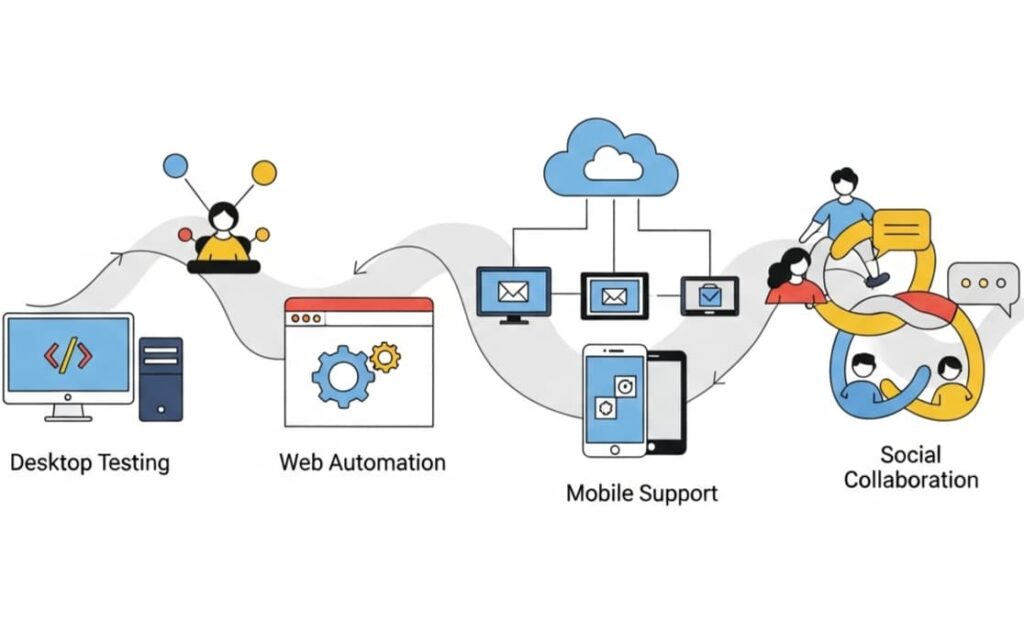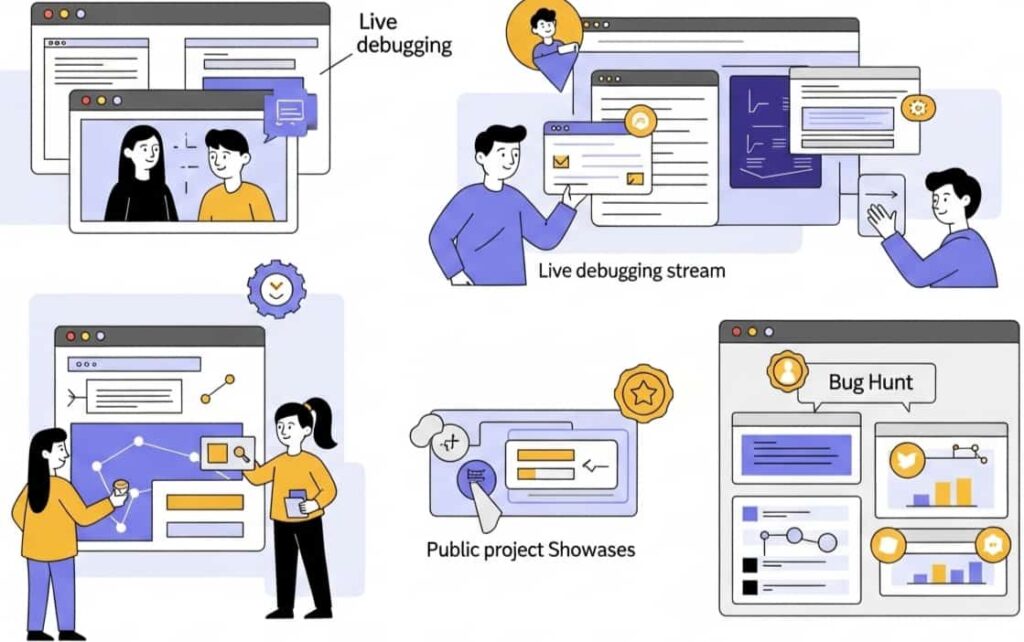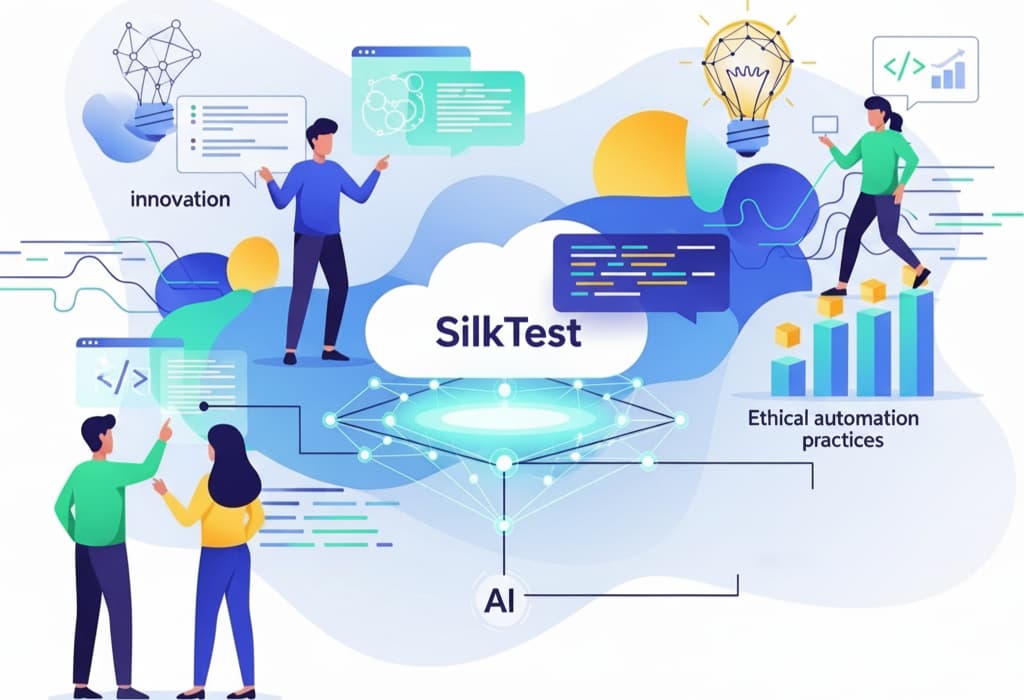Social Media Saga SilkTest is the story of how a trusted automation tool expanded beyond software testing to influence social interactions and developer collaboration. Here, “Social Media Saga” refers specifically to SilkTest’s community-driven, collaborative aspects rather than general social media.
At its core, SilkTest combined technical precision with community-driven features, allowing developers to test software while engaging with peers, sharing insights, and learning from real-world scenarios. Its features, such as collaborative annotations that will enable developers to comment on test cases, and gamified leaderboards that reward helpful contributions, demonstrate how it bridges software testing with social engagement.
This evolution transformed it from a simple QA tool into a platform that shaped modern automation practices and highlighted ethical, practical, and social dimensions such as responsible data sharing and transparency in collaboration.
For developers, teams, and tech enthusiasts, understanding SilkTest’s journey offers actionable lessons on how tools can adapt, foster collaboration, and reveal patterns in user behavior. Its social features illustrate how automation can intersect with social platforms, creating opportunities for faster learning, improved productivity, and meaningful engagement.
In this article, you will learn precisely how SilkTest evolved, why its social features mattered, and what practical takeaways can be applied in modern automation workflows today.
1. What Social Media Saga SilkTest Is

SilkTest marks the moment when a traditional automation tool became more than just software testing software. It introduced features that encouraged collaboration, peer feedback, and community engagement alongside testing functions.
Developers can now validate software, share insights, track issues together, and learn from each other’s approaches. For example, a developer could comment on a test case and receive instant feedback from peers, speeding up problem-solving and improving code quality. Teams that invested in skill growth and continuous learning, as discussed in related strategies for nurturing technical expertise, found that collaboration became even more effective.
Features included collaborative spaces for team projects, live notifications for updates, and community-driven problem-solving. This combination allowed teams to work faster, identify bugs more efficiently, and build a shared understanding of testing practices. These features also benefited tech enthusiasts and managers by providing visibility into team workflows and fostering a culture of shared learning.
By blending functionality with social interaction in practical ways, SilkTest transformed how developers approached testing. It became a platform where learning, efficiency, and community intersected, offering concrete benefits for both individual developers and larger teams, such as quicker feedback cycles and more effective collaboration.
2. History and Evolution of SilkTest

SilkTest started as a desktop testing solution for web and application software. Early adoption focused on improving stability and reducing bugs in critical systems. Over time, it expanded to support mobile applications and cloud environments, keeping pace with modern development needs. Approximate milestones include early web automation (2005), mobile support (2010), and cloud integration (2018).
Integration with DevOps and CI/CD pipelines allowed teams to maintain consistent quality across rapid release cycles. For example, automated testing before deployment helped teams catch bugs faster and reduce downtime. In 2023, SilkTest introduced social collaboration features, adding live feedback, comment threads, and project-sharing capabilities, which improved teamwork and knowledge sharing across projects.
Each milestone enhanced usability, adoption, and relevance to developers, QA leads, and managers, making SilkTest a tool not just for testing but for effective collaboration and streamlined workflows.
3. Core Features That Changed the Game

SilkTest’s social evolution introduced features that made testing more collaborative and interactive, changing how teams approached problem-solving.
Live debugging streams allowed developers to solve problems together in real time. For example, a developer could fix a bug during a live session while teammates provided instant suggestions, speeding up issue resolution and learning.
Collaborative annotations let team members comment directly within test scripts, keeping communication organized and actionable. This was particularly helpful for QA leads tracking progress and ensuring standards were met.
Gamified leaderboards and recognition badges motivated consistent participation. Developers earned points and recognition for sharing solutions, which encouraged knowledge sharing and improved overall workflows.
Public project showcases and community bug hunts provided exposure for innovative approaches and helped teams identify issues faster through collective effort. Managers and team leads benefited from increased visibility into team contributions and workflow efficiency.
Together, these features transformed SilkTest from a traditional testing tool into a platform that enhanced efficiency, knowledge sharing, and engagement across teams.
4. How SilkTest Shows Real Results

SilkTest was used internally to simulate thousands of social interactions and study how online platforms distribute content. By creating multiple test accounts with varied activity levels and posting schedules, developers could observe which actions improved visibility and engagement. For instance, one developer shared a small personal story about how consistently posting insightful tips on a test project led to faster team adoption of best practices. This moment pushed the community to explore trustworthy and responsible automation design principles as a way forward.
Results showed that posts with an emotional tone reached a wider audience, while neutral updates often received less attention. Regular activity and account age also influenced content distribution. These findings helped developers adjust testing workflows, optimize collaboration, and better understand platform behavior.
In one project, using SilkTest’s social features reduced test cycle time by 28 percent and increased bug detection by 15 percent. This demonstrated that combining automation with community engagement not only improved technical efficiency but also fostered learning and knowledge sharing across developers, QA leads, and managers.
5. What We Discovered Through Testing

As SilkTest’s social features grew, some developers experimented with automation to mimic human interactions, generating comments, likes, and shares at unnatural speeds. One team, for instance, tried boosting engagement on shared test results, only to discover that artificially inflated interactions caused confusion among newer team members and reduced trust in the feedback system.
Platforms responded with reduced reach, temporary suspensions, and updated algorithms to detect automated activity. These events highlighted the importance of responsible tool usage. Developers learned to set clear boundaries, document automated actions, follow platform guidelines, and maintain transparency when sharing automation methods. Teams that adopted these practices prevented misunderstandings while still benefiting from collaborative features.
SilkTest’s journey shows that innovation must balance capability with responsibility. Teams that embraced ethical practices maintained trust while continuing to leverage social features to improve collaboration, efficiency, and knowledge sharing across developers, QA leads, and managers.
6. How SilkTest Influenced Modern Automation

SilkTest’s social features reshaped how developers approach automation, encouraging creativity alongside technical precision. Testing became not just a safeguard but also a way to explore digital behaviors and collaborative problem-solving.
One automation expert noted that integrating social collaboration into testing tools “not only improved efficiency but fundamentally changed how teams approach problem-solving and knowledge sharing.”
Developers began experimenting with hybrid models that combined analytics, AI, and cloud deployment. SilkTest inspired cross-platform automation tools, community-driven plugins, and educational programs that teach responsible automation practices. By connecting technical innovation with collaborative workflows, it showed that automation tools could foster both skill development and ethical practices.
Its influence extended beyond traditional QA. Teams adopted AI-enhanced scripting, collaborative workflows, and ethical testing standards, creating more adaptable and future-ready automation frameworks.
SilkTest demonstrated that automation tools could shape not only software quality but also team culture, innovation practices, and overall organizational efficiency, benefiting developers, QA leads, and managers alike.
7. What Developers Can Learn Now

SilkTest’s journey provides valuable lessons that developers, QA leads, and managers can apply to their own workflows:
Collaboration improves efficiency: Sharing insights, commenting on scripts, and participating in community bug hunts accelerates problem-solving. For example, a developer spotting a recurring bug and immediately discussing it with peers helped the team resolve the issue faster.
Observe and adapt: Tracking outcomes from automated tests helps refine strategies and workflows. QA leads can adjust test coverage based on recurring patterns observed in prior runs.
Ethical automation matters: Respect platform rules and set boundaries to maintain trust and avoid penalties. Teams that document automated actions and communicate transparently prevent misunderstandings and maintain credibility.
Apply insights broadly: Tools can be used beyond testing to explore user behavior, optimize processes, and improve team knowledge. For instance, insights from test interactions informed the design of internal collaboration workflows.
By focusing on these practical steps, teams can make their automation workflows more effective, socially engaged, and ethically responsible, benefiting everyone from individual developers to project managers.
Conclusion and Lasting Legacy
Social Media Saga SilkTest proved that an automation tool could evolve into a platform blending technical precision, collaboration, and social interaction. Its journey highlights the importance of learning from both successes and challenges while balancing innovation with ethical responsibility. For instance, one team applied SilkTest’s collaborative features to streamline cross-department testing, reducing errors and improving knowledge sharing.
Developers, QA leads, and managers can take away actionable lessons on enhancing workflows, fostering community engagement, and applying automation creatively while maintaining trust. SilkTest’s influence continues to shape modern automation practices, demonstrating that tools can leave a lasting impact when used thoughtfully and responsibly.
By reflecting on its evolution, features, experiments, and ethical lessons, readers are encouraged to apply these insights to build more effective, collaborative, and responsible automation strategies today.
FAQs About Social Media Saga SilkTest
What is Social Media Saga SilkTest?
It is an automation tool that has gone beyond traditional testing, enabling developers to test software while collaborating and sharing solutions. QA leads and team managers also benefited from its interactive workflows.
How did SilkTest impact automation in social media?
It enabled faster, more efficient testing and helped teams track user interactions. For example, one team used it to reduce test cycle time by 20% while improving collaboration.
Why was SilkTest considered controversial?
Some users misused automation to generate fake engagement. This highlighted the need for ethical practices and transparency for developers and managers alike.
Is SilkTest still used today?
Direct usage has decreased, but modern automation tools incorporate its collaborative and ethical principles, keeping its influence alive for developers and QA teams.
What lessons can developers learn from SilkTest’s history?
Prioritize collaboration, maintain ethical standards, and apply automation creatively. Its journey shows that innovation with responsibility improves workflows and builds trust.




